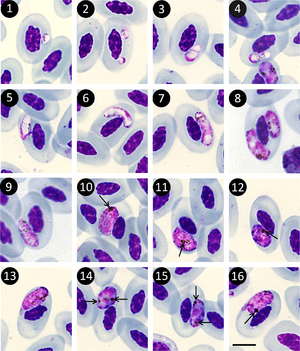Aconoidasida facts for kids
Quick facts for kids Aconoidasida |
|
|---|---|
 |
|
| Haemoproteus ilanpapernai (Haemoproteidae) | |
| Scientific classification | |
| Domain: | |
| Kingdom: | |
| Superphylum: | |
| Phylum: | |
| Class: |
Aconoidasida
|
| Orders | |
|
Haemosporida |
|
The Aconoidasida are a group of very tiny living things called apicomplexan parasites. These parasites live inside other animals and can sometimes cause diseases. They are special because they do not have a cone-shaped part called a "conoid," which many other apicomplexa parasites do have.
Contents
What are Aconoidasida?
Aconoidasida belong to a larger group called Apicomplexa. These are all parasites, meaning they live inside another living thing (called a host) and get their food from it, often harming the host. Aconoidasida are unique because they lack a specific structure called a conoid. This conoid is like a small, cone-shaped organelle that helps other apicomplexa parasites attach to and enter host cells.
Where Do Aconoidasida Live?
These parasites are found all over the world. They usually live inside the cells of different animals, including humans, birds, and other mammals. They often live in the blood cells or other tissues of their hosts.
How Do Aconoidasida Spread?
Aconoidasida parasites often spread from one host to another through insects. For example, some types of Aconoidasida are carried by mosquitoes or ticks. When these insects bite an infected animal, they pick up the parasites. Then, when they bite another animal, they can pass the parasites on.
Main Types of Aconoidasida
The Aconoidasida class is divided into two main groups, called orders. These orders include many different types of parasites.
Haemosporida Parasites
- What they are: Parasites in the Haemosporida group are known for living in the blood of their hosts.
- How they spread: They are often spread by biting insects like mosquitoes, flies, or ticks.
- Examples: The most famous example from this group is Plasmodium, which causes malaria in humans. There are also other types that infect birds and other animals.
Piroplasmida Parasites
- What they are: Piroplasmida parasites also live in the blood, especially in red blood cells.
- How they spread: They are typically spread by ticks.
- Examples: Babesia is a well-known parasite from this group. It can cause a disease called babesiosis in humans and animals, which is similar to malaria. Another example is Theileria, which causes diseases in cattle.
Why Are Aconoidasida Important?
Studying Aconoidasida is very important for several reasons:
- Health: Many of these parasites cause serious diseases in humans and animals. Understanding them helps scientists find ways to prevent and treat these illnesses.
- Agriculture: Diseases caused by Aconoidasida can harm farm animals, leading to big losses for farmers.
- Science: Learning about these tiny parasites helps us understand more about how living things interact and how diseases spread.
See also
 In Spanish: Aconoidasida para niños
In Spanish: Aconoidasida para niños

